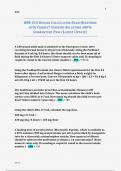1
BSN
BSN 215 DOSAGE CALCULATION EXAM QUESTIONS
WITH CORRECT VERIFIED SOLUTIONS 100%
GUARANTEED PASS (LATEST UPDATE)
A 180-pound adult male is admitted to the Emergency Center after
receiving thermal burns to 60 percent of his body. Using the Parkland
formula of 4 ml/kg/24 hours, the client should receive how many ml of
fluid during the first 24 hours? (Enter numeric value only. If rounding is
required, round to the nearest whole number.) - ANS ✓19632
Using the Parkland formula, the client's fluid requirements for the first 24
hours after injury: 4 ml lactated Ringer's solution x Body weight (in
kilograms) x Percent burn. Convert 180 pounds to kg = .2 = 81.8 kg 4
ml x 81.8 kg x 60 = 19632 ml over the first 24 hours.
The healthcare provider prescribes acetazolamide (Diamox) 600
mg/m2/day divided into 3 doses. The nurse calculates the child's body
surface area (BSA) as 0.7 m2. How many mg should the child receive per
dose? (Enter numeric value only.) - ANS ✓140
Using the child's BSA, 0.7 m2, calculate the mg/dose,
600 mg x 0.7 m2 =
420 mg/day/3 doses = 140 mg/dose
A loading dose of acetylcysteine (Mucomyst) 8 grams, which is available as
a 20% solution (200 mg acetylcysteine per ml) is prescribed by nasogastric
tube for a client with acetaminophen toxicity. How many ml of diluent
should be added to the medication to obtain a 1:4 concentration? (Enter
numeric value only. If rounding is required, round to the nearest whole
number.) - ANS ✓120
BSN 215
, 2
BSN
8 grams = 8,000 mg prescribed dose. Using the formula, D/H x Q, 8,000 mg /
200 mg x 1 ml = 40 ml of the 20% solution. Dilute the 40 ml to a 1:4
concentration for administration using ratio and proportion, 1 : 4
solution :: 40 ml : X X= 160 ml total volume to administer. Subtract total
volume of 160 ml - 40 ml of 20% concentration = 120 ml diluent is added to
obtain a 1:4 concentration.
A child who weighs 55 pounds receives a prescription for atovaquone with
proguanil (Malarone Pediatric) 125 mg/50 mg PO daily. A drug reference
states that children 11 to 20 kg should receive 1 pediatric tablet daily; 21 to
30 kg should receive 2 pediatric tablets daily; 31 to 40 kg should receive 3
pediatric tablets daily; and greater than 40 kg should receive 1 adult tablet
daily with food. The drug is available as atovaquone 62.5 mg/proguanil 25
mg pediatric tablets. How many tablets should the nurse administer? - ANS
✓2
Calculate each drug component dose, using the formula, D/H 125 mg / 62.5
mg (atovaquone) = 2 combined with 50 mg / 25 mg (proguanil) = 2. The
child should receive 2 tablets.
A client receives a prescription for azithromycin (Zithromax) 500 mg PO x
3 days. Azithromycin is available as 250 mg scored tablets. How many
tablets should the nurse administer per dose? (Enter numeric value only. -
ANS ✓2
Using the formula, DO/DA
500 mg/250 mg
= 2 tablets
A child who is scheduled for a kidney transplant receives a prescription for
basiliximab (Simulect) 20 mg IV 2 hours prior to surgery. The medication is
available in a 20 mg vial that is reconstituted by adding 5 ml sterile water
for injection, and administered in a 50 ml bag of normal saline over 30
minutes. The nurse should program the infusion pump to deliver how many
ml/hour? (Enter numeric value only. - ANS ✓110
BSN 215
, 3
BSN
After reconstituting the medication vial, the nurse adds the 5 ml of
medication to the 50 ml of sterile water to result in a 55 ml volume to
infuse in 30 minutes. Using the formula, Volume/Time = 55 ml / 0.5 hours =
110 ml/hour
The nurse notes that a client is receiving an oxytocin (Pitocin) infusion via a
pump that is programmed to deliver 30 ml/hour. The available solution is
Ringer's Lactated 1,000 ml with Pitocin 20 units. How many
milliunits/minute is the client receiving? (Enter numeric value only.) - ANS
✓10
Convert units to milliunits,
20 x 1,000 = 20,000 units.
Using D/H x Q =
30 ml/hour X/20,000 units x 1,000 ml
= 30 ml/hour (60 minutes) X/20 =30/60, reduce X/2 = 1/2, and 2X = 20, so
X = 10 milliunits/minute OR 20/1,000 = 0.02 1000 : 0.02 :: 30 : X = 0.6 ::
1,000X X = 600 and 600/60 = 10 milliunits/minute.
A client is receiving Heparin Sodium 25,000 Units in 5% Dextrose Injection
500 ml IV at 1,000 unit/hour per protocol for acute coronary syndrome
(ACS). The client's partial thromboplastin time (PTT) is 76 seconds. Based
on the ACS protocol, the infusion should be decreased by 100 units/hour
for a PTT between 71 to 80 seconds. The nurse should program the pump
to deliver how many ml/hour? (Enter numeric value only.) - ANS ✓18
Adjust the infusion to 900 units/hour (1,000 units/hour minus 100
units/hour per protocol). Using the formula, D/H x Q, 900 units/1 hour
divided by 25,000 units x 500 ml = 90/5= 18 ml/hour.
The healthcare provider prescribes oxytocin (Pitocin) 0.5
milliunits/minute for a client in labor. One liter Ringer's Lactate with 10
units of oxytocin (Pitocin) is infusing. The nurse should program the
infusion pump at how many ml/hour? (Enter numeric value only.) - ANS ✓3
BSN 215




